Why need to change the wireless channel of the router?
Dual-band routers are capable of transmitting and receiving data, using both 2.4GHz and 5GHz frequencies, simultaneously or one of these frequencies at a time. The 2.4 and 5GHz Wi-Fi signal range is divided into a number of smaller strips called wireless channels. Each wireless channel translates to a specific radio frequency (for example, channel 6 is 2.437GHz).
You need to change the wireless channel of the router when the signal is noisy. Interference is one of the most common problems that home networks often encounter and this can be caused by the following:
- Electronics in your home (cordless phones, speakers and microwave ovens)
- Nearby wireless networks
- Physical obstacles (walls, mirrors or glass)
- Distance or location
These factors can reduce network performance. Changing channels is one of the best ways to solve intermittent signal interruption and optimize your wireless connection.
- Unexpected items in the house silently "breaking" Wi-Fi waves
Why need to change the wireless channel of the router?
- How to change the channel for the router
- 2.4GHz band
- 5GHz band
- Various devices you can use to expand your network
How to change the channel for the router
To change the channel for the router, do the following:
NOTE : The available wireless channels may vary depending on your region. Images and options may also vary depending on the router model.
Step 1:
Access the router's web-based setup page.
Step 2:
On the web-based settings page of the router, click the Wireless tab .
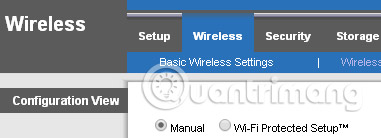
Step 3:
On the Basic Wireless Settings tab , select Manual. Select Manual setup to allow you to adjust the wireless channel according to your preferences. Once completed, you can click Save Settings.
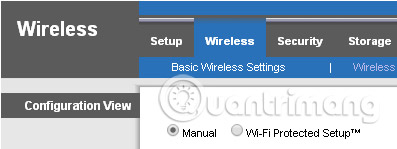
For some models, you do not need to select Manual anymore. Instead, simply click the Wireless> Basic Wireless Settings , find the Wireless Channel and then make your changes via the menu that appears.
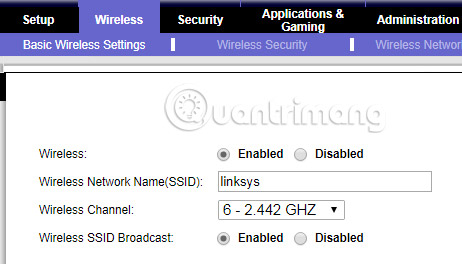
QUICK TIP : If you are using a dual-band router simultaneously, you need to take the following steps for both frequencies (2.4GHz and 5GHz).
Step 4:
For a 5GHz network, you can switch to 20MHz or 40MHz for Channel Width. For 2.4GHz network, the available Channel Width is 20MHz.
QUICK TIP: To avoid interference with other 2.4GHz networks in the area, Channel Width must be set to 20MHz Only for both networks.

Step 5:
Click the drop-down arrow in the Channel, then select your favorite channel. In the example below, the 2.4GHz network is located on Channel 6 .
QUICK TIP : Recommended channels for 2.4GHz networks are 1, 6, 9 and 11 as they are considered non-overlapping channels. For 5GHz networks , channels 36, 40, 44 and 48 are recommended because there is less chance of interference. For Linksys Wi-Fi routers, it's best to switch channels to Auto, if you don't experience any connection problems.

Step 6:
Click Save Settings.
The information below explains and differentiates wireless channels of dual-band routers.
2.4GHz band
The 2.4GHz band has 11 channels available, 0.005GHz apart from the Channel Width of 20MHz. When your wireless device is set to channel 6, you are using frequencies of channels 5 and 7 and half of channels 4 to 8. Ideally, your network should be at least 5 channels away from other networks. (25MHz) to avoid frequency overlap. Different but adjacent channels (such as 1, 2 and 3) use the same spectrum and will interfere with each other.
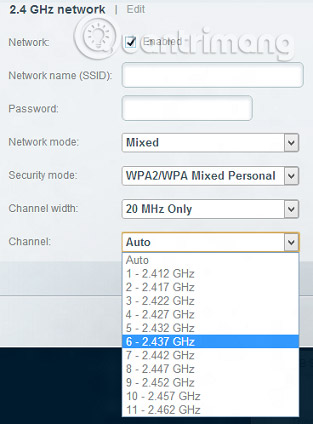
The 2.4GHz band has three non-overlapping channels: 1, 6 and 11. The most commonly used channel is 6. If you are experiencing noise on this channel, switch to channel 1 or 11. If the noise persists , consider switching to other channels. To help you better understand, please refer to the example below:
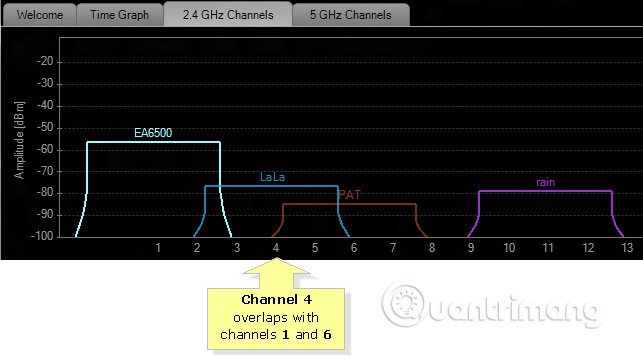
There are four wireless networks in this example, namely: EA6500, LaLa, PAT and rain. Each network is set to a different wireless channel. Here are the details:
- EA6500 is playing on Channel 1
- LaLa is playing on Channel 4
- PAT is playing on Channel 6
- rain is playing on Channel 11
Because EA6500, PAT and rain are 5 channels apart, their signals do not match. On the other hand, LaLa, despite being on a separate channel, hindered EA6500 and PAT.
5GHz band
Connection problems are not common on the 5GHz band. There are quite a few devices available to use this band. Along with 23 non-overlapping channels, the 5GHz band is less noisy. Each channel is 20MHz apart, providing more available bandwidth.
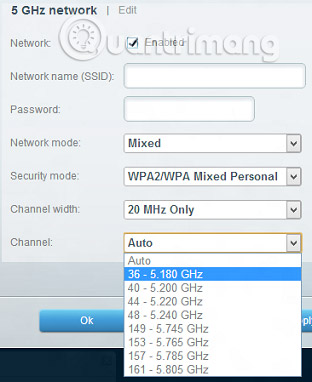
You should choose the 2.4GHz band for web browsing and simple email viewing. For streaming media and other heavy activities like gaming and Internet voice calls (VoIP), consider switching to the 5GHz band.
QUICK TIP : When the wireless range decreases, the frequency increases. Therefore, the 5GHz band is ideal for home networks with devices that are not too far apart. For networks that require wider reach, choose the 2.4GHz band.
Various devices you can use to expand your network
If you still have trouble connecting after changing the wireless channel, you may need to add another device to your home network, such as a switch or range extender. In this way, you can connect more devices to the network and expand the range of wireless networks.
- Tips to increase Wifi signal to the highest level
See more:
- 7 things affect the speed of WiFi network
- Several ways to improve Wi-Fi connection
- Top 10 basic network troubleshooting tools that IT people need to know
You should read it
- 5 advantages and disadvantages for 5GHz Wi-Fi router
- Set up 802.11n Channel Bonding to achieve 300Mbps speed
- Change the channel of Wifi Router to maximize signal
- Here's how to change your YouTube channel name and URL
- 5 settings need to change right on your new router
- Instructions for changing settings in Wi-Fi Router
- What is a dual-band and tri-band router?
- How to Check WiFi Band on iPhone
May be interested
- Here's how to change your YouTube channel name and URL
 if you want to change your youtube channel name with a memorable and impressive name, attract users to subscribes, like and comment on your youtube channel. refer to the steps to change your youtube channel name and url in the following article of network administrator.
if you want to change your youtube channel name with a memorable and impressive name, attract users to subscribes, like and comment on your youtube channel. refer to the steps to change your youtube channel name and url in the following article of network administrator. - Set up 802.11n Channel Bonding to achieve 300Mbps speed
 in order for the 802.11n connection to run at maximum speed, the wireless-n broadband router and network adapter must be linked up and running in what is known as channel bonding.
in order for the 802.11n connection to run at maximum speed, the wireless-n broadband router and network adapter must be linked up and running in what is known as channel bonding. - Which type of wireless router has the longest range?
 different standards - including 802.11b, 802.11g and 802.11n - of both the wireless adapter and access point will affect the maximum range. however, solving certain problems can improve the range of any wireless router.
different standards - including 802.11b, 802.11g and 802.11n - of both the wireless adapter and access point will affect the maximum range. however, solving certain problems can improve the range of any wireless router. - How to set a password for Wireless
 setting a password for a wireless device cpnf is called config wireless router. if you buy a good router, there will be documentation and manuals included. from there, you can set the encryption mode, security at your disposal. if in case you don't
setting a password for a wireless device cpnf is called config wireless router. if you buy a good router, there will be documentation and manuals included. from there, you can set the encryption mode, security at your disposal. if in case you don't - How to set up WEP, WPA, WPA2 for Linksys router
 wireless connection is a necessity today and because of that, wireless security is essential to ensure safety in your local network.
wireless connection is a necessity today and because of that, wireless security is essential to ensure safety in your local network. - 5 tips to help make optimal use of Tomato on the Router
 in the following article, we will show you the 5 most useful tips for tomato, which help speed up your router and your work is done faster.
in the following article, we will show you the 5 most useful tips for tomato, which help speed up your router and your work is done faster. - Top 5 best Xiaomi WiFi routers
 wireless routers are being used in almost every corner of the world today. the best wireless router will ensure your network connections are strong and reliable.
wireless routers are being used in almost every corner of the world today. the best wireless router will ensure your network connections are strong and reliable. - 3 best wireless routers 2021
 whether you want the fastest and most powerful wifi router, feature set that focuses on gaming or wifi speeds just right and won't leave you out of pocket, there's always a wireless router option for you. it is important to know what to look for.
whether you want the fastest and most powerful wifi router, feature set that focuses on gaming or wifi speeds just right and won't leave you out of pocket, there's always a wireless router option for you. it is important to know what to look for. - Create a virtual wireless Router with Windows
 in this tutorial we will show you how to create a virtual wireless router in windows to share internet connection and file sharing.
in this tutorial we will show you how to create a virtual wireless router in windows to share internet connection and file sharing. - Review Tenda N301: The router is compact and affordable
 the tenda n301 router was released in 2013. tenda n301 is equipped with broadcom bcm5357c0 300 mhz chipset, 16mb ram and 2mb flash memory. tenda n301 wifi router is compatible with ieee 802.11b / g / n standards.
the tenda n301 router was released in 2013. tenda n301 is equipped with broadcom bcm5357c0 300 mhz chipset, 16mb ram and 2mb flash memory. tenda n301 wifi router is compatible with ieee 802.11b / g / n standards.










 How to choose the best WiFi channel for the router
How to choose the best WiFi channel for the router Instructions for choosing the right Wi-Fi router
Instructions for choosing the right Wi-Fi router Summary of the best Wi-Fi Router devices
Summary of the best Wi-Fi Router devices Restart the router and modem properly?
Restart the router and modem properly? The router is not as safe as you think
The router is not as safe as you think What is Kodi Box?
What is Kodi Box?